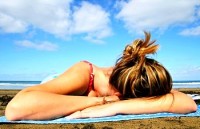Little Sunshine Mistakes that Can Give You Cancer Instead of Vitamin D

By Dr. Mercola
Unfortunately, due to decades of professional and media misinformation, the typical American believes they should avoid the midday sun and need to use sunscreen before, and several times during, sun exposure. Unfortunately, this is a prescription for minimizing vitamin D levels and all its widely appreciated benefits. The purpose of this article is to provide you with some practical guidelines on how to use natural sun exposure to optimize your vitamin D benefits.
.
Your Initial Exposure
The first few days, you should limit your exposure to the sun to allow your body’s melanocyte cells to rev up the ability to produce protective pigmentation that not only gives you a tan, but also serves to help protect you against overexposure to the sun. If you are a fairly light skinned individual that tends to burn, you will want to limit your initial exposure to a few minutes, especially if it is in the middle of summer. The more tanned your skin will get, and/or the more tanned you want to become, the longer you can stay in the sun. If it is early or late in the season and/or you are a dark skinned individual, you could likely safely have 30 minutes on your initial exposure. If you are deeply pigmented and your immediate ancestors are from Africa, India or the Middle East, it is possible you may not even have to worry about the timing of your exposure.
.
Always err on the side of caution however, and let it be your primary goal to never get sun burned. You can use a moisturizing, safe, NON-SPF cream to moisturize your skin, or use something as simple as organic coconut oil to moisturize your skin as this will also benefit you metabolically. Remember if the moisturizer you use has an SPF value, it will block UVB rays and will not allow your body to produce any vitamin D. The rest of the day, you can spend in the shade, wear clothes, and, if you still want to be in the open sun, use a non-toxic lotion with SPF15 for uncovered skin. Just be sure to be on the safe side of burning!
.
Protect Your Face and Eyes
The skin around your eyes and your face is typically much thinner than other areas on your body and is a relatively small surface area so will not contribute much to vitamin D production. It is strongly recommended to protect this fragile area of your body as is at a much higher risk for cosmetic photo damage and premature wrinkling. You can use a safe sun block in this area or wear a cap that always keeps your eyes in the shade like I do when I am outside seeking to increase my vitamin D levels.
.
Prepare Your Skin and Keep Your Vitamin-D Supply Constant
Before you travel, prepare your skin by having sessions (1-2 times per week) in a solarium with low-pressure UV-lamps that has a reasonable percentage UVB. This will also protect you against vitamin D deficit between your vacations. The time for each session depends on how strong the tubes in the solarium are. In countries that follow the EU-norm you probably will need 15-20 minutes, while in less regulated countries, 5-10 minutes might be enough. The operator of the tanning place should be able to advice you.
.
How Do You Know if You Are Getting Enough Vitamin D?
The key point to understand is that sunlight is composed of about 1500 wavelengths, but the only wavelength that will have your body make vitamin D are UVB-rays when they shine on unexposed skin. The key is that the UVB-rays from the sun actually have to pass through the atmosphere and reach where you are on the earth. This obviously does not occur in the winter for most of us, but the sun’s rays are also impeded during a fair amount of the year for people living in temperate climates. So how do you know if you have entered into the summer season and into the time of year, for your location, where enough UVB is actually able to penetrate the atmosphere to allow for vitamin D production in your skin?
.
It should be noted that this represents a very small portion of the total radiation from the sun that reaches the earth’s surface. Much is filtered out by our atmosphere. So due to the physics and wavelength of UVB rays it will only penetrate the atmosphere when the sun is above an angle of about 50� from the horizon. When the sun is lower than 50�, the ozone layer reflects the UVB-rays but let through the longer UVA-rays.
The first step is to determine the latitude and longitude of your location. You can easily do this on Google Earth, or if you are in the U.S. you can use the TravelMath Latitude Longitude Calculator to find your latitude and longitude i. Once you have obtained that you can go to the U.S. Navy site to calculate a table to determine the times and days of the year that the sun is above 50 degrees from the horizon ii. Please view the video at the top of this page. The URL for the US Naval Observatory Azimuth table is http://aa.usno.navy.mil/data/docs/AltAz.php
.
For a more detailed understanding of this you can visit the University of Colorado State’s page iii that discusses this in more detail. If you read the paper you will see that there are other factors, such as ozone concentration, altitude, air pollution, ground covered by snow or ice, and cloud cover that also contribute to the amount of UVB that is ultimately reaching your skin.
.
Translated to the date and time of some places on the globe, it means for example: In my hometown of Chicago, the UVB rays are not potentially present until March 25, and by September 16th it is not possible to produce any vitamin D from the sun in Chicago. Please understand it is only theoretically possible to get UVB rays during those times. If it happens to be cloudy or raining, the clouds will also block the UVB rays.
.
This is one of the reasons I now spend most of my winters in the sunshine state of Florida because in the center of the state there are more than two extra months of UVB as the sun doesn’t disappear for winter until October 23 and comes back again much earlier, around February.
.
When NOT to Tan
.
From a health perspective it doesn’t make much sense to expose your skin to the sun when it is lower than 50 degrees above the horizon because you will not receive any valuable UVB rays, but you will expose yourself to the more
.
After Sun Exposure, Be Careful about Showering!
.
It’s important to understand that vitamin D3 is an oil soluble steroid hormone. It’s formed when your skin is exposed to ultraviolet B (UVB) radiation from the sun (or a safe tanning bed). When UVB strikes the surface of your skin, your skin converts a cholesterol derivative in your skin into vitamin D3. However, the vitamin D3 that is formed is on the surface of your skin does not immediately penetrate into your bloodstream. It actually needs to be absorbed from the surface of your skin into your bloodstream. The critical question then is: how long does it take the vitamin D3 to penetrate your skin and reach your bloodstream? If you’re thinking about an hour or two, like I did until recently, you’re wrong. Because new evidence shows it takes up to 48 hours before you absorb the majority of the vitamin D that was generated by exposing your skin to the sun!
.
Therefore, if you shower with soap, you will simply wash away much of the vitamin D3 your skin generated, and decrease the benefits of your sun exposure. So to optimize your vitamin D level, you need to delay washing your body with soap for about two full days after sun exposure. Now, few are not going to bathe for two full days. However you really only need to use soap underneath your arms and your groin area, so this is not a major hygiene issue. You’ll just want to avoid soaping up the larger areas of your body that were exposed to the sun.
.
Many will dispute this recommendation as “conventional” thinking teaches that vitamin 
.
.
However, this has been extensively tested in animals and that is precisely where the vitamin D3 is formed. In fact that is where most of the oral vitamin D3 in supplements comes from�the lanolin and the sebum-like material in the skin of sheep and cows. Additionally, you can rub vitamin D3 on your skin and it easily penetrates into your bloodstream (assuming you don’t wash it off for 48 hours). This is also likely the reason why surfers in Hawaii who are in the sun and water continuously don’t have vitamin D levels comparable to lifeguards that don’t go in the water. The surfers typically have levels in the 70s while the lifeguards and others who are in the sun as much without going into the water will have vitamin D levels around 100. The bottom line is that washing the sebum off of your skin is NOT ideal and should be avoided when possible. You were NOT designed to use soap on your entire body. It is fine to wash areas that are prone to bacterial overgrowth such as your axilla (armpits) and groin, but it is in your best interest to leave the sebum that was designed to be on your skin, on your skin.
.
Obviously you can do as you wish, but it is my STRONG recommendation to avoid soap on most of your skin.
.
Avoid Tanning through a Window as it Will Increase Your Skin Cancer Risk
.
Because the UVA has a longer wavelength, it penetrates materials more easily, such as the earth’s atmosphere and window glass which will effectively filter out the majority of UVB radiation, but only minimally filters out UVA’s. What’s the significance of that, you ask?
.
It’s important to remember that vitamin D3 is formed from exposure to UVB rays, whereas UVA radiation actually destroys vitamin D. This helps keep your body in balance; it’s one of the protective mechanisms your body has to
.
Normally, of course, when you get tanned from outdoor sun exposure you’re getting both UVA and UVB at the same time, so it’s not a problem. But when you are indoors and expose yourself to sunlight filtered through window glass, you are increasing your risk of a variety of conditions, primarily skin cancer, because the UVA’s are effectively destroying your vitamin D3 levels while you’re getting none of the benefits from UVB, and this can significantly increase your risk of skin cancer. This is one of the reasons why many that drive long hours in their cars develop skin cancer on the arm next to the car window.
.
The Antioxidant that Reverses Skin Aging from the Inside Out
.
An excellent adjunct to vitamin D is the antioxidant astaxanthin. Not only can it act as an internal sunscreen, protecting your skin from harmful radiation�both solar and medical radiation�but it also appears to have a rejuvenating effect on skin in general. Two human clinical studiesivwere recently performed to test the effects of astaxanthin on skin aging. In the first, 30 healthy female subjects were given six mg per day of oral astaxanthin plus two ml per day topical astaxanthin application, for eight weeks. The women showed improvement in:
- Skin wrinkle size
- Age spot size
- Elasticity
- Skin texture, and
- Corneocyte layer moisture content
.
The second study was a similar test on 36 healthy male subjects for 6 weeks. The men showed improvement in crow’s feet wrinkle size and elasticity, transepidermal water loss, moisture content and sebum oil level. According to the authors:
.
"These results suggest that astaxanthin derived from Haematococcus pluvialis may improve the skin condition in not only in women but also in men."
.
What to Do if You Get Sunburned
If you ever develop a sunburn it is important to realize that aloe vera is one of the best remedies to help repair your skin as it is loaded with powerful glyconutrients that accelerate healing. Ideally, it is best to use the gel from a fresh plant, but there are commercial products available that have active aloe in them. Ideally you would never need it because you are using these safe tanning guidelines, but accidents do happen and it is important to have contingency plans for them.
.
Testing Your Blood is the Only Way to Know Your Vitamin D Levels
The above guidelines are the most comprehensive details that I know of that will allow you to optimize your vitamin D levels by natural sun exposure. However, there are other variables that you can’t control, such as the darkness of your skin and your age, which can add further confusion to the ability to accurately predict what your vitamin D level will be after appropriate sun exposure.
.
I can tell you that these guidelines work and have personally used them to maximize my vitamin D levels. I have not taken any oral vitamin D for years now. Last spring, with one to two hours of sun exposure regularly, I was able to get my vitamin D level to 105, which is typical of lifeguards that are not using sun screens.
.
I would strongly encourage you to have your blood level checked to confirm that your sun exposure is putting you in the right level. If it isn’t, or if sun exposure is not a practical option for you, then you should consider supplementing with oral vitamin D3. (You want to avoid vitamin D2 as it is clearly inferior to D3.) The following chart shows the therapeutic levels of vitamin D you’ll want to reach and maintain.
.






